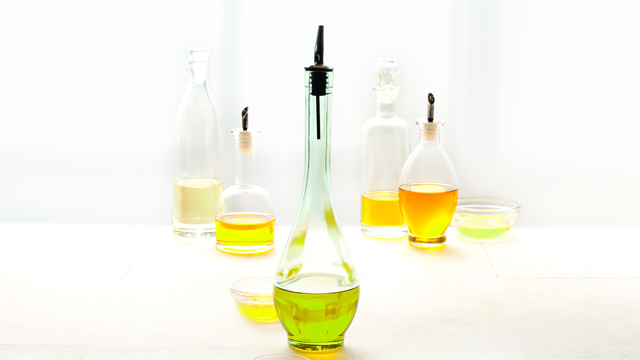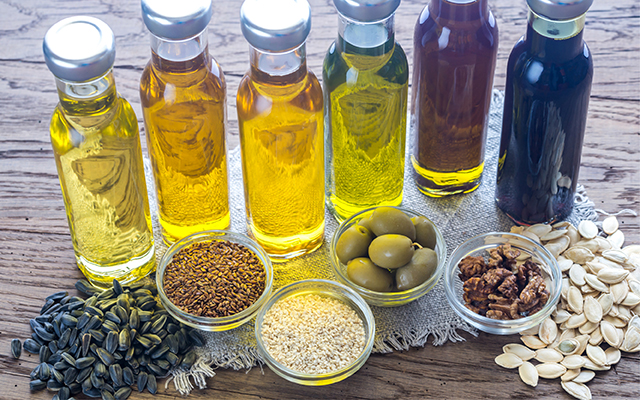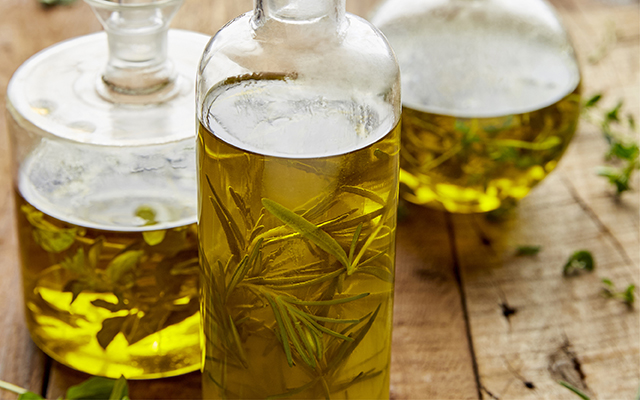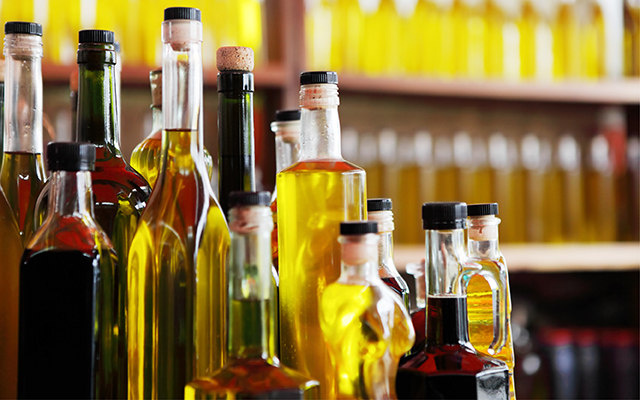Olive oil is like wine. It can contain a multitude of subtle aromatic and flavor differences, from flowery and fruity to earthy and nutty. There’s cheap stuff and pricey stuff, and price is often (but not always) a decent indicator of quality.
Most olive oil imported to the United States comes from Italy, Spain and Turkey, but olive oil is also produced in Greece, Portugal, California, Palestine, Australia, South Africa, France and Croatia. People like to debate which country produces the most delectable olive oils (“Italian is richest! No, Spain’s softer taste rules! Greece’s grassy quality is divine!”), but frankly, such preferences are intensely personal. Moreover, flavor varies not just by country, but by region within a given country, so it’s almost impossible to generalize.
As with wine, differences in flavor are also determined by variety of olive tree, soil and climate, and especially by how the oil is processed.
So how do you choose? Your first priority should be finding a good but affordable extra-virgin olive oil you like for everyday use. From there, you’ll want to experiment to find out what olive oils you like for special-use purposes like dipping, dressing, drizzling and marinading, or for recipes that call for milder and more robust oil flavors.
A great way to determine which olive oils you prefer is to purchase small bottles from different countries and producers and conduct a sample tasting. Either swirl a small amount in a cup and sip, or dip into the oil with a baguette. Note the different flavors and aromas. A strong, rich extra-virgin olive oil would pair nicely with grilled beef or white bean purée or drizzled on sautéed greens. A lighter one would complement fish, vegetable, pesto and pasta dishes.
In general, extra-virgin olive oil should have a deep-green or golden color. It may have a range of flavor undertones: fruity (which you can smell); bitter (which you taste on the back of the tongue); and peppery (which you feel in the back of the throat). Flavors you don’t want to find? Rancid, musty, burnt, muddy or vinegary, which indicate poor processing or storage.
To learn more about the finer points of this nutritional superfood, read on.
Nutrition Know-How
- Eating an olive-oil-rich “Mediterranean diet” has been shown to reduce the risk of chronic illnesses, such as heart disease, atherosclerosis, diabetes, colon cancer and asthma.
- In one study, exclusive use of olive oil when preparing foods — as opposed to other fats — decreased the likelihood of coronary heart disease by an amazing 47 percent.
- One tablespoon of extra-virgin olive oil offers nearly 45 percent of the recommended daily amount of monosaturated fats and about 4 percent of omega-3 fatty acids.
- The chemical makeup of specific olives — their phenolic compounds — determines an oil’s pungency and offers antioxidant activity. Extra-virgin olive oil has higher levels of polyphenolic phytonutrients than more refined olive oils. They lower LDL or “bad” cholesterol and improve heart health.
- Oleocanthal is a natural organic compound isolated from extra-virgin olive oil. It gives the oil its peppery bite, and its anti-inflammatory properties can help ward off chronic disease.
- Olive oil’s green-gold color comes from chlorophyll and the carotenoid pigments beta-carotene and lutein, which are all antioxidants. Carotenoids also enhance the immune system.
- The vitamin E in olive oil helps protect your cells from free radicals, and your brain from Alzheimer’s disease.
Kitchen Tricks
- With the exception of high-heat deep-fat frying, using extra-virgin olive oil is the best choice for cooking, including sautéing, stir-frying, and for rubbing on meats when grilling and roasting. But avoid heating extra-virgin olive oil above 350 degrees F, because the unrefined particles within the oil will burn, ruining the taste and leading to possible toxicity (overheating can create polycyclic aromatic hydrocarbons, or PAHs, which are carcinogenic).
- The fine, delicate flavors of extra-virgin olive oil make it the best choice when preparing salad dressings, marinades and dipping sauces, and when finishing prepared dishes, such as potatoes and vegetables, and seasoning most fresh-cooked items.
- To preserve the most nutrients, add olive oil to foods after cooking, if possible.
More Ways to Enjoy
- Instead of buttering bread, serve it brushed with mild-flavored olive oil — or simply place a small dish of oil on the table for dipping.
- Drizzle a small amount of extra-virgin olive oil over fresh mozzarella, tomatoes and basil for homemade caprese salad.
- For a basic crostini, generously brush small rounds of good-quality bread with olive oil and bake at 350 degrees F until golden. Toss fresh roasted red peppers with additional olive oil and basil, then serve the mixture on crostini.
- Make your own olive-oil infusion by decanting oil into a small, dark bottle and then submerging a sprig or two of fresh herbs, plus salt and pepper to taste. Let flavors mingle for a couple of days in sealed bottle. Fresh infused oils are great on salads or in marinades and will keep for about a week in the refrigerator.
Keep It Fresh
- Buy olive oil in dark, opaque containers. They cut down on exposure to damaging sunlight and grocery-store fluorescents, which can speed up the oxidation that causes oils to go rancid.
- Elevated temperatures also speed oxidation, so once you’re home, store olive oil away from heat and light.
- Any time you open a container, you let in air and speed spoilage. If you’re a heavy user, consider buying a big tin of olive oil, then pour a week’s worth into a small bottle and store it at room temperature. (Keep the rest in its original container in the refrigerator. Oil gets cloudy when refrigerated, but will become clear again at room temperature.)
- It’s best to use olive oil within a few months of purchase. Studies show that at one year, olive oil’s nutrients have significantly declined.
- Fresh olive oil has a fruity, pleasant smell. If it smells bitter or dusty or oily, it’s probably gone bad. Start over with some new stuff — and purchase a smaller quantity next time!
Get the Good Stuff
Faced with an entire shelf of olive-oil options, all with different labels and price points, how do you choose? Start with these pointers from the California Olive Oil Council (COOC), a nonprofit organization that recently petitioned the USDA to develop clearer olive-oil standards:
- Opt for “extra.” As a rule, you’re best off choosing extra-virgin olive oil, which gives you more nutrition and flavor for your buck. Just plain “virgin,” while cheaper, tends to be less flavorful and have fewer health benefits.
- Don’t be dazzled by claims. The labels “cold pressed,” “cold extracted” and “first press” have little meaning when attached to extra-virgin and virgin olive oils, all of which must be processed that way to earn the virgin or extra-virgin designation.
- Avoid also-rans. The labels “olive oil,” “pure olive oil,” “light olive oil” and “refined olive oil” are lower-quality olive oils that do not meet virgin standards and have been refined to make them palatable.
- Look for the harvest or milling date, which indicates when the olives were picked; it should be within the last 12 months. If there is no such date, estimate the harvest date by looking for the “best by” expiration date, which is generally 18 months to two years after the harvest.
- Steer clear of imposters. Even the hallowed label of “extra-virgin olive oil” can be misleading. According to a recent report, more than two-thirds of imported extra-virgin olive oils (and one in 10 California extra-virgin olive oils) are actually lower-quality olive oils that may also be cut with other kinds of oils, such as canola, safflower and peanut. Read on for tips on how to spot the real stuff.
- Look for the USDA seal. The presence of the USDA seal indicates that the oil has been produced in accordance with the new regulations governing the use of the label “extra-virgin olive oil.” If you’re buying domestic, look for the COOC’s “Extra Virgin Seal” for oils made in California, which produces 99 percent of domestic olive oil.
- Buy from a reputable source. Better grocery stores and specialty retailers are less likely than big-box bargain outlets to sell low-quality oils from questionable sources. Specialty retailers are also much more likely to let you taste the oil before you buy it.
- Beware of too-good bargains. Although you can get a liter of certified California extra-virgin olive oil for $10 to $25, says COOC’s executive director Patricia Darragh, if you see a liter of imported extra-virgin olive oil for under $10, it’s probably too good to be true: “The Euro is currently strong, and then you add in fees associated with shipping across the Atlantic and suddenly you’re only spending a few dollars for ‘extra-virgin olive oil’? It’s not financially feasible.”
Red Snapper Scented With Orange and Olive Oil, Baked in a Foil Package
Baking fish in foil packages keeps it moist and steeps it in the flavors of any added ingredients. Drizzling olive oil over hot fish just before serving creates an amazing aroma and deepens the flavors of the fish, herbs and vegetables.
Makes four servings
- Four (20-by-15-inch) pieces of aluminum foil
- Four (4-ounce) skinless red snapper fillets
- 2 tbs. fresh herb mix: chopped basil, parsley, chives and oregano
- Two carrots, peeled and cut into 3-inch batons
- One zucchini, cut into 3-inch batons
- Eight Kalamata olives, sliced thin
- One orange: zest and juice
- 3 tbs. extra-virgin olive oil
Directions
- Preheat the oven to 450 degrees F.
- Season the fish on both sides with fresh herbs. Place one fillet on half of each piece of foil.
- Top each fillet with four carrot batons, two zucchini batons, and one-fourth of the olives. Sprinkle with orange zest and drizzle with 1 tablespoon of orange juice over each fillet.
- Fold each piece of foil in half over the fillets. Begin with a folded corner. Twist and fold the edges together to form a half-moon package. Seal the end tightly by twisting it. Repeat with remaining packages.
- Place packages on baking sheet and bake for 10 minutes. Cut the packages open to serve and drizzle each with 2 teaspoons extra-virgin olive oil.
Baked Italian Acorn Squash
In the fall, sweet and slightly caramelized baked squash is a real treat. Try topping it with fresh herbs and olive oil, or drizzle with cinnamon and maple syrup.
Makes four servings
- Two small acorn squash, cut in half, seeds removed
- 1/4 cup pine nuts, roughly chopped
- 2 tbs. grated Parmesan cheese
- 1 tbs. extra-virgin olive oil
Directions
- Preheat the oven to 350 degrees F.
- Place the squash cut-side up on a baking sheet.
- Combine the pine nuts and Parmesan cheese in a bowl. Drizzle the squash halves with olive oil and sprinkle the Parmesan mixture on top.
- Bake for 35 to 45 minutes or until the squash is golden brown on top and soft when a knife is inserted.
Lemon Aioli
This French-style mayonnaise of garlic, olive oil and lemon is wonderful as a condiment with steamed or grilled vegetables, fish and soups, or as a spread when making sandwiches. Lasts for one week in a tightly sealed jar in the refrigerator.
Makes 1 1/2 cups
- Three garlic cloves, chopped
- 1 cup extra-virgin olive oil
- Two large egg yolks
- 1 tsp. lemon zest
- 2 tbs. fresh lemon juice
- 1/2 tsp. sea salt to taste
- 1/8 tsp. ground white pepper
Directions
- Place chopped garlic in blender with 1 tablespoon of olive oil and blend until smooth, about one minute.
- Add egg yolks and lemon zest and blend until smooth and frothy, about two minutes.
- Add olive oil in a slow, steady stream until emulsified.
- Add lemon juice, 1 teaspoon at a time, to achieve desired taste and consistency.
- Season with salt and white pepper.
Classic Vinaigrette
Makes four servings
- 2 tbs. white balsamic vinegar
- 1/2 tsp. salt
- 1/4 tsp. freshly ground pepper
- 1/2 cup extra-virgin olive
Directions
- In a small bowl, mix the vinegar and salt. Add the pepper and slowly whisk in the oil. Taste and adjust seasoning with additional salt or vinegar, if needed.
- Store in a jar with a tight lid and shake well before using.
For a Creamy Mustard Vinaigrette: Add 1 1/2 teaspoons Dijon mustard and 1/2 teaspoon minced garlic; blend well.
For a Basil Garlic Vinaigrette: Replace infused basil oil for olive oil and add 1 tablespoon minced shallots; blend well.
Basil Oil
Basil oil is bright, fragrant and simply delicious. Use it to brighten up the flavor and appearance of a host of dishes, such as flatbreads, grilled fish, roast chicken, grilled vegetables, puréed eggplant or fried eggs.
Makes 2 1/2 cups
- 2 cups packed basil leaves, washed, stems removed
- 1 tsp. minced garlic
- 2 cups olive oil
- 1/2 tsp. sea salt
Directions
- Blanch basil leaves in boiling water for four to five seconds. Remove and immediately plunge into an ice bath to cool.
- Remove from water and squeeze excess water out of basil.
- Place blanched basil leaves into blender bowl with minced garlic, salt and ¼ cup of oil and blend at low speed until smooth.
- Slowly add remaining olive oil in a thin stream and increase blender speed to medium high. Blend on high speed for 30 seconds.
- Serve as a purée or as clear oil by straining basil oil through a cheesecloth to remove all basil particles.
- Store in refrigerator up to one week.





This Post Has 0 Comments